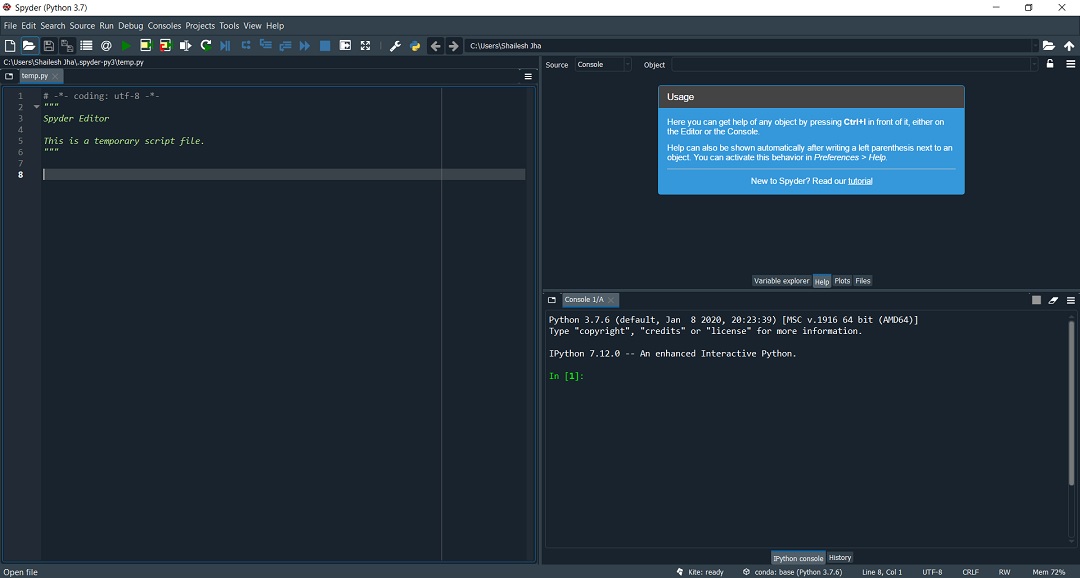


- Anaconda navigator upgrading spyder install#
- Anaconda navigator upgrading spyder driver#
- Anaconda navigator upgrading spyder software#
Starting with version 1.9.0, the conda TensorFlow packages are built using the Intel® MKL-DNN library, which demonstrates considerable performance improvements. The conda TensorFlow packages are also designed for better performance on CPUs through the use of the Intel® Math Kernel Library for Deep Neural Networks (Intel® MKL-DNN). Finally, because these libraries are installed via conda, users can easily create multiple environments and compare the performance of different CUDA versions. This can be important when working on systems which do not support the newer version of the CUDA libraries. The pip packages only supports the CUDA 9.0 library. For example, packages for CUDA 8.0, 9.0, and 9.2 are available for the latest release at this time, version 1.10.0.
Anaconda navigator upgrading spyder driver#
Regardless of using pip or conda-installed tensorflow-gpu, the NVIDIA driver must be installed separately.įor many versions of TensorFlow, conda packages are available for multiple CUDA versions. Furthermore, conda installs these libraries into a location where they will not interfere with other instances of these libraries that may have been installed via another method.
Anaconda navigator upgrading spyder install#
When the GPU accelerated version of TensorFlow is installed using conda, by the command “conda install tensorflow-gpu”, these libraries are installed automatically, with versions known to be compatible with the tensorflow-gpu package. When installing TensorFlow using pip, the CUDA and CuDNN libraries needed for GPU support must be installed separately, adding a burden on getting started. The gain in acceleration can be especially large when running computationally demanding deep learning applications. Many of the functions in TensorFlow can be accelerated using NVIDIA GPUs. This is a further benefit of the conda packages: in spite of being labeled as manylinux1-compatible (works on many versions of linux), the wheels available on PyPI support only a minimum of Ubuntu 16.04, which is much newer than many enterprise Linux installations. The Linux packages for the 1.10.0 release support a number of Linux distributions including older distributions such as CentOS 6. TensorFlow conda packages are available for Windows, Linux, and macOS. Like other packages in the Anaconda repository, TensorFlow is supported on a number of platforms. These packages are installed into an isolated conda environment whose contents do not impact other environments. Additionally, any of the 1,400+ professionally built packages in the Anaconda repository can be installed alongside TensorFlow to provide a complete data science environment.

Anaconda navigator upgrading spyder software#
This is done automatically users do not need to install any additional software via system packages managers or other means. When TensorFlow is installed using conda, conda installs all the necessary and compatible dependencies for the packages as well. One key benefit of installing TensorFlow using conda rather than pip is a result of the conda package management system. These packages are available via the Anaconda Repository, and installing them is as easy as running “conda install tensorflow” or “conda install tensorflow-gpu” from a command line interface. Installing TensorFlow using conda packages offers a number of benefits, including a complete package management system, wider platform support, a more streamlined GPU experience, and better CPU performance. There are a number of methods that can be used to install TensorFlow, such as using pip to install the wheels available on PyPI. Released as open source software in 2015, TensorFlow has seen tremendous growth and popularity in the data science community. TensorFlow is a Python library for high-performance numerical calculations that allows users to create sophisticated deep learning and machine learning applications.


 0 kommentar(er)
0 kommentar(er)
